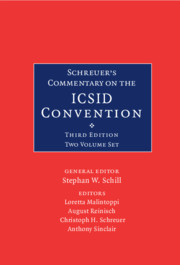121 results
Foreword to the Second Edition
-
- Book:
- Schreuer's Commentary on the ICSID Convention
- Published online:
- 17 September 2022
- Print publication:
- 22 September 2022, pp xi-xii
-
- Chapter
- Export citation
Contributors
-
- Book:
- Schreuer's Commentary on the ICSID Convention
- Published online:
- 17 September 2022
- Print publication:
- 22 September 2022, pp xvi-xviii
-
- Chapter
- Export citation
Index
-
- Book:
- Schreuer's Commentary on the ICSID Convention
- Published online:
- 17 September 2022
- Print publication:
- 22 September 2022, pp 1751-2026
-
- Chapter
- Export citation
Final Clause
-
- Book:
- Schreuer's Commentary on the ICSID Convention
- Published online:
- 17 September 2022
- Print publication:
- 22 September 2022, pp 1728-1730
-
- Chapter
- Export citation
Preamble
-
- Book:
- Schreuer's Commentary on the ICSID Convention
- Published online:
- 17 September 2022
- Print publication:
- 22 September 2022, pp 1-9
-
- Chapter
- Export citation
Contents
-
- Book:
- Schreuer's Commentary on the ICSID Convention
- Published online:
- 17 September 2022
- Print publication:
- 22 September 2022, pp v-viii
-
- Chapter
- Export citation
Table of Instruments
-
- Book:
- Schreuer's Commentary on the ICSID Convention
- Published online:
- 17 September 2022
- Print publication:
- 22 September 2022, pp cxi-clxvi
-
- Chapter
- Export citation
Editors’ Preface to the Third Edition
-
- Book:
- Schreuer's Commentary on the ICSID Convention
- Published online:
- 17 September 2022
- Print publication:
- 22 September 2022, pp xiii-xv
-
- Chapter
- Export citation
General Bibliography
-
- Book:
- Schreuer's Commentary on the ICSID Convention
- Published online:
- 17 September 2022
- Print publication:
- 22 September 2022, pp 1731-1750
-
- Chapter
- Export citation
Foreword to the Third Edition
-
- Book:
- Schreuer's Commentary on the ICSID Convention
- Published online:
- 17 September 2022
- Print publication:
- 22 September 2022, pp ix-x
-
- Chapter
- Export citation
Convention on the Settlement of Investment Disputes between States and Nationals of Other States
-
- Book:
- Schreuer's Commentary on the ICSID Convention
- Published online:
- 17 September 2022
- Print publication:
- 22 September 2022, pp clxxiii-cxc
-
- Chapter
- Export citation
Frontmatter
-
- Book:
- Schreuer's Commentary on the ICSID Convention
- Published online:
- 17 September 2022
- Print publication:
- 22 September 2022, pp i-iv
-
- Chapter
- Export citation
Abbreviations
-
- Book:
- Schreuer's Commentary on the ICSID Convention
- Published online:
- 17 September 2022
- Print publication:
- 22 September 2022, pp clxvii-clxxii
-
- Chapter
- Export citation
Table of Cases
-
- Book:
- Schreuer's Commentary on the ICSID Convention
- Published online:
- 17 September 2022
- Print publication:
- 22 September 2022, pp xix-cx
-
- Chapter
- Export citation

Schreuer's Commentary on the ICSID Convention
- A Commentary on the Convention on the Settlement of Investment Disputes between States and Nationals of Other States
-
- Published online:
- 17 September 2022
- Print publication:
- 22 September 2022
Contributors
-
-
- Book:
- Prospects in International Investment Law and Policy
- Published online:
- 05 April 2013
- Print publication:
- 18 April 2013, pp xi-xiv
-
- Chapter
- Export citation
Contents
-
- Book:
- The ICSID Convention
- Published online:
- 07 September 2010
- Print publication:
- 23 July 2009, pp v-viii
-
- Chapter
- Export citation
Index by article
-
- Book:
- The ICSID Convention
- Published online:
- 07 September 2010
- Print publication:
- 23 July 2009, pp 1327-1393
-
- Chapter
- Export citation
Article 9 - Composition of Secretariat
- from CHAPTER I - International Centre for Settlement of Investment Disputes
-
- Book:
- The ICSID Convention
- Published online:
- 07 September 2010
- Print publication:
- 23 July 2009, pp 32-33
-
- Chapter
- Export citation
CHAPTER IV - Arbitration
-
- Book:
- The ICSID Convention
- Published online:
- 07 September 2010
- Print publication:
- 23 July 2009, pp -
-
- Chapter
- Export citation



